Oct 01, 2009
Cosmic Rays Hit Space Age High
By Dr. Tony Phillips, NASA
Planning a trip to Mars? Take plenty of shielding. According to sensors on NASA’s ACE (Advanced Composition Explorer) spacecraft, galactic cosmic rays have just hit a Space Age high.
“In 2009, cosmic ray intensities have increased 19% beyond anything we’ve seen in the past 50 years,” says Richard Mewaldt of Caltech. “The increase is significant, and it could mean we need to re-think how much radiation shielding astronauts take with them on deep-space missions.” (below, enlarged here)
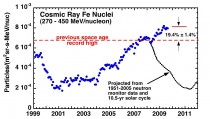
The cause of the surge is solar minimum, a deep lull in solar activity that began around 2007 and continues today. Researchers have long known that cosmic rays go up when solar activity goes down. Right now solar activity is as weak as it has been in modern times, setting the stage for what Mewaldt calls “a perfect storm of cosmic rays.”
“We’re experiencing the deepest solar minimum in nearly a century,” says Dean Pesnell of the Goddard Space Flight Center, “so it is no surprise that cosmic rays are at record levels for the Space Age.”
Galactic cosmic rays come from outside the solar system. They are subatomic particles--mainly protons but also some heavy nuclei--accelerated to almost light speed by distant supernova explosions. Cosmic rays cause “air showers” of secondary particles when they hit Earth’s atmosphere; they pose a health hazard to astronauts; and a single cosmic ray can disable a satellite if it hits an unlucky integrated circuit.
The sun’s magnetic field is our first line of defense against these highly-charged, energetic particles. The entire solar system from Mercury to Pluto and beyond is surrounded by a bubble of solar magnetism called ”the heliosphere.” It springs from the sun’s inner magnetic dynamo and is inflated to gargantuan proportions by the solar wind. When a cosmic ray tries to enter the solar system, it must fight through the heliosphere’s outer layers; and if it makes it inside, there is a thicket of magnetic fields waiting to scatter and deflect the intruder.
“At times of low solar activity, this natural shielding is weakened, and more cosmic rays are able to reach the inner solar system,” explains Pesnell.
Mewaldt lists three aspects of the current solar minimum that are combining to create the perfect storm:
1. The sun’s magnetic field is weak. “There has been a sharp decline in the sun’s interplanetary magnetic field (IMF) down to only 4 nanoTesla (nT) from typical values of 6 to 8 nT,” he says. “This record-low IMF undoubtedly contributes to the record-high cosmic ray fluxes.” The heliospheric current sheet is shaped like a ballerina’s skirt. Credit: J. R. Jokipii, University of Arizona
2. The solar wind is flagging. “Measurements by the Ulysses spacecraft show that solar wind pressure is at a 50-year low,” he continues, “so the magnetic bubble that protects the solar system is not being inflated as much as usual.” A smaller bubble gives cosmic rays a shorter-shot into the solar system. Once a cosmic ray enters the solar system, it must “swim upstream” against the solar wind. Solar wind speeds have dropped to very low levels in 2008 and 2009, making it easier than usual for a cosmic ray to proceed.
3. The current sheet is flattening. Imagine the sun wearing a ballerina’s skirt as wide as the entire solar system with an electrical current flowing along the wavy folds. That is the “heliospheric current sheet,” a vast transition zone where the polarity of the sun’s magnetic field changes from plus (north) to minus (south). The current sheet is important because cosmic rays tend to be guided by its folds. Lately, the current sheet has been flattening itself out, allowing cosmic rays more direct access to the inner solar system.
“If the flattening continues as it has in previous solar minima, we could see cosmic ray fluxes jump all the way to 30% above previous Space Age highs,” predicts Mewaldt. Earth is in no great peril from the extra cosmic rays. The planet’s atmosphere and magnetic field combine to form a formidable shield against space radiation, protecting humans on the surface. Indeed, we’ve weathered storms much worse than this. Hundreds of years ago, cosmic ray fluxes were at least 200% higher than they are now. Researchers know this because when cosmic rays hit the atmosphere, they produce an isotope of beryllium, 10Be, which is preserved in polar ice. By examining ice cores, it is possible to estimate cosmic ray fluxes more than a thousand years into the past. Even with the recent surge, cosmic rays today are much weaker than they have been at times in the past millennium.
“The space era has so far experienced a time of relatively low cosmic ray activity,” says Mewaldt. “We may now be returning to levels typical of past centuries.” NASA spacecraft will continue to monitor the situation as solar minimum unfolds. Stay tuned for updates. See post and comments here.
Icecap Note: This will provide a test of the Svensmark theory for the correlation of low cloud cover and galactic cosmic rays. (depicted below, enlarged here)
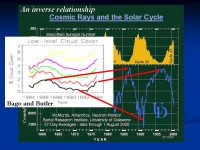
Different color lines in Bago and Butler insert plot represent different latitude belts. Note also in the background graph, the inverse relationship of cosmic rays with solar sunspot activity.
In the theory, more galactic rays leads to greater ion-mediated nucleation of low water droplet clouds and thus more cloud cover. Low clouds reflect solar radiation and lead to cooling. When the sun is active, the cosmic galactic rays are diffused resulting in less low cloud cover and more short wave solar radiation reaching and warming the ground. We should with these very high levels of cosmic rays be measuring more low clouds and cooling (depicted by Friis-Christensen below, enlarged here)
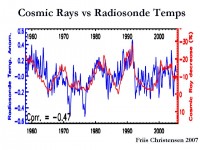
ICECAP NOTE: although an active sun may pose increased health risks such as skin cancer from 6-8% increases in ultraviolet, a low sun and enhanced cosmic rays in addition to increased radiation risks for astronauts in space, has been suggested in the literature of having its own health risk for fetuses, ironically showing a few generations later. See this PDF.
Oct 01, 2009
Cap-and-Switch: Hello Sucker!
By Alan Caruba
Here’s a look at the introduction of a draft bill co-sponsored by Sen. Barbara Boxer (D-CA), co-sponsored by John Kerry (D-MA). It is the Senate alternative to the horrid “Cap-and-Trade” bill authored by Rep. Henry Waxman (D-CA) and Rep. Ed Markey (D-MA). Call it “Cap-and-Switch.”
IN THE SENATE OF THE UNITED STATES
A bill to create clean energy jobs, achieve energy independence, reduce global warming pollution, and transition to a clean energy economy.
All those who believe Santa Claus, the Easter Bunny, and the Jolly Green Giant are real should stop reading now.
Let’s look at the objectives of the Senate version of a huge tax on all energy use by every American. As I will note later, the bulk of the cost will fall on low-and-middle income households.
“To create clean energy jobs.” This is pure bunk. Such jobs would be primarily in the production of solar and wind energy. Other such jobs involve biofuels such as ethanol. Combined, solar and wind represent barely one percent of all the electricity generated daily in the nation. If solar and wind were profitable, you can be sure that American entrepreneurs would have long ago become more active, but if it were not for taxpayer dollars subsidizing solar and wind, neither would likely exist. The only thing ethanol has done has been to raise the cost of the corn from which it is made and reduce the mileage of every gallon of gasoline to which it is added.
Testifying, Sept. 30 before the House Committee on Small Business, Manning Feraci, vice president of federal affairs for the National Biodiesel Board was seeking a continuation of the industry tax incentive. He said “the industry is in the midst of an economic crisis. Plants are having difficulty accessing operating capital. Volatility in commodity markets and reduced demand for biodiesel in both domestic and global markets are making it difficult for producer to sell fuel.” Nobody wants it!
There will be few “clean energy jobs” as compared to the employment that coal, oil and natural gas industries currently provide and could expand upon if the government wasn’t trying to put them out of business.
“Achieve energy independence.” Are you stupid? Boxer, Kerry, Waxman and Markey think you are. So does the President and many members of Congress.
How does America achieve “energy independence” when it will not allow the oil in Alaska’s ANWR to be extracted? When 85% of the nation’s offshore continental shelf, home to estimated billions of barrels of oil and trillions of cubic feet of natural gas, is off-limits to any exploration and drilling? When the President wants to eliminate the current subsidies that encourage oil companies to invest billions to find new reserves? When there is a full-scale attack on America’s coal industry even though coal provides half of all the electricity we use?
Just how does America “achieve energy independence” under such circumstances? How, indeed, do we heat or cool our homes, run our businesses, or even turn on the lights if Congress is opposed to the acquisition and use of our known and estimate energy reserves? Pretty soon, for reasons that defy understanding, Americans will not even be able to purchase an incandescent light bulb in the nation where it was invented!
“Reduce global warming pollution.” First of all, there is NO global warming. Why would Congress pass a law intended to deal with something that is a complete hoax? And what is global warming pollution? Is it the second most essential gas to all life on Earth, carbon dioxide (CO2)? If so, this law is scientifically absurd and baseless. CO2 never had anything to do with the warming that occurred after the end of the last little ice age, around 1850.
No matter what the Supreme Court and others have ruled, if CO2 is a “pollutant”, than we should all be in jail because that’s what we and other mammals exhale. It also occurs when energy sources such as coal and oil are used to keep factories producing, along with hospitals, schools, airports, seaports, and the Capitol of the United States functioning.
“Transition to a clean energy economy.” Oh sure, just as soon as we cover hundreds of thousands of acres of America with solar mirrors and wind turbines, we can make that transition. We have an economy that is dependent on coal, oil and natural gas. We have abundant natural reserves. What we don’t have is a President and Congress with the intelligence to understand that China is building a new coal-fired plant every week to meet its energy needs, that India has an aggressive nuclear energy program going for its economy, and this single piece of legislation will destroy any hope that the American economy can recover and grow strong again.
According to a study of the Waxman-Markey bill by Andrew Chamberlain, it will be the shareholders, not ratepayers, that will be the primary beneficiaries of cap-and-trade’s absurd creation of a market for the purchase and sale of “carbon credits.” It will be based on how much CO2 a utility, industrial, or any other entity is producing. The credits will literally permit them to keep on “polluting” even though that means “global warming” would, in theory, just get worse. Even though there is NO global warming. Make sense to you?
Chamberlain succinctly says, “These new findings should send a clear message to the American people (that) cap-and-trade helps the powerful and hurts the rest of us. And as Congress’ corporate allies receive the bulk of the benefits Waxman-Markey has to offer, our environment, along with our struggling economy, will suffer for years to come.”
“Congress needs to get out of the business of picking winners and losers and allow the market to determine which energy and electricity sources should power our economy.” I leave you with a short list of just some of the U.S. corporations seeking to benefit from this hideous piece of legislation. Twelve of them sent an open letter to the U.S. Senate urging swift action on the climate change bill. They are Bumble Bee Foods, Dell, DuPont, FPL Group, Google, HP, Johnson & Johnson, Johnson Diversity, Levi Strauss & Company, Nike, PG&E Corporation, and Xanterra Parks and Resorts.
Time to let your Congressman and Senators know you think this is a very bad idea.
Sep 29, 2009
IPCC Claim RegardingThe Global Average Surface Temperature Trends and Radiative Forcing
By Roger Pielke Sr., Climate Science
In our paper ”Klotzbach, P.J., R.A. Pielke Sr., R.A. Pielke Jr., J.R. Christy, and R.T. McNider, 2009: An alternative explanation for differential temperature trends at the surface and in the lower troposphere. J. Geophys. Res., in press [with edits still to be made in the final published version; see],
we show that the surface and lower tropospheric temperature trends are diverging in time. We offer an explantion for some of this related to the use of minimum temperatures over land as part of the construction of the global average surface temperature trend. Other sources of bias and uncertainty are reported in our 2007 JGR paper [Pielke et al 2007: Unresolved issues with the assessment of multi-decadal global land surface temperature trends].
This also means that the diagnosis of the radiative forcing using the surface temperature trends introduces errors. The assumption of a linear relationship between the radiatve forcings and surface temperature is clearly stated in the 2007 IPCC WG1 report (e.g. see Chapter 2 page 133), where it is written
“Radiative forcing [RF] can be related through a linear relationship to the global mean equilibrium temperature change at the surface (delta Ts): delta Ts = lambda * RF, where lambda is the climate sensitivity parameter (e.g.,Ramaswamy et al., 2001).”
The lower troposphere is also expected to have a linear relationship to the radiative forcing although amplified relative to the surface; e.g. see Figure 5.6 for the tropics in CCSP 1.1. Chapter 5.
Our Klotzbach et al 2009 paper shows that there is not a temporally invariant linear relationship between the global average surface and lower tropospheric temperature trends. Based on this paper, and our other papers such as JGR 2007, there is also not a linear relationship between the global average surface temperature trends and the radiative forcing. This view is at significant variance to the IPCC view, which used the CCSP 1.1 report in its assessment. In our new Klotzbach et al paper, we present additional observational evidence that the paragraph above from the IPCC report is not correct, and we discuss one of the reasons for the discrepancy.

Enlarged here.
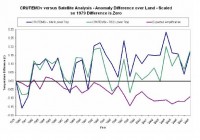
Enlarged here.
The 2005 NRC report supports our view where it is written
“The simplification of complex, mechanistically disparate processes to the same radiative forcing metric, with the implication that positive forcings may cancel negative forcings, provides a way of easily communicating climate forcing factors and their relative importance to general audiences. However, a net zero global mean radiative forcing may be associated with large regional or nonradiative (e.g., precipitation) changes. Further, when forcings are added, uncertainties in individual forcings must be propagated, resulting in large uncertainties in the total forcing. Adding forcings also belies the complexity of the underlying chemistry, physics, and biology. It suggests that all effects on climate can be quantified by a similar metric without knowing, or needing to know, the details of the climate response as captured in feedback effects. Yet there are many aspects of climate change - including rainfall, biodiversity, and sea level - that are currently not related quantitatively, much less linearly, to radiative forcings.”
See post here.
Sep 29, 2009
Mann-made Warming Confirmed
By Chris Horner, Planet Gore
It turns out that trees can scream.
A colleague in the climate-realist blogosphere sends along the following narrative which all Planet Gore readers, even the muttering monitors over at Team Soros, should find very interesting. The inescapable and powerful conclusion is that Mann-made warming is real, while man-made warming remains at best a theory, more likely a hypothesis. Really.
This story deserves to be told.
1: In 1998, a paper is published by Dr. Michael Mann, then at the University of Virginia, now a Penn State climatologist, and co-authors Bradley and Hughes. The paper is named: Northern Hemisphere Temperatures During the Past Millennium: Inferences, Uncertainties, and Limitations. The paper becomes known as MBH98.
The conclusion of tree ring reconstruction of climate for the past 1,000 years is that we are now in the hottest period in modern history, ever.
See the graph here.
Steve McIntyre, a Canadian mathematician in Toronto, suspects tree rings aren’t telling a valid story with that giant uptick at the right side of the graph, implicating the 20th century as the “hottest period in 1000 years,” which alarmists latch onto as proof of AGW. The graph is dubbed the “Hockey Stick” and becomes famous worldwide. Al Gore uses it in his movie An Inconvenient Truth in the famous “elevator scene.”
2: Steve attempts to replicate Michael Mann’s tree ring work in the paper MBH98, but is stymied by lack of data archiving. He sends dozens of letters over the years trying to get access to data but access is denied. McIntyre and Ross McKitrick, of the University of Guelph publish a paper in 2004 criticizing the work. A new website is formed in 2004 called Real Climate, by the people who put together the tree ring data and they denounce the scientific criticism here.
3: Years go by.McIntyre is still stymied trying to get access to the original source data so that he can replicate the Mann 1998 conclusion. In 2008 Mann publishes another paper in bolstering his tree ring claim due to all of the controversy surrounding it. A Mann co-author and source of tree ring data (Professor Keith Briffa of the Hadley UK Climate Research Unit) used one of the tree ring data series (Yamal in Russia) in a paper published in the Philosophical Transactions of the Royal Society in 2008, which has a strict data archiving policy. Thanks to that policy, Steve McIntyre fought and won access to that data just last week.
4: Having the Yamal data in complete form, McIntyre replicates it, and discovers that one of Mann’s co-authors, Briffa, had cherry picked 10 tree data sets out of a much larger set of trees sampled in Yamal.
5: When all of the tree ring data from Yamal is plotted, the famous hockey stick disappears. Not only does it disappear, but goes negative. The conclusion is inescapable. The tree ring data was hand-picked to get the desired result.
These (here and here) are the relevant graphs from McIntyre showing what the newly available data demonstrates.

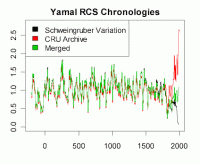
So now the question is, if tree rings scream and their message is one that few want to hear, does their message get heard? See post here.
Sep 29, 2009
Relationship between Solar Cycle Length and Global Temperature Anomalies
Stephen Strum, Frontier Weather, Inc.
The most recent solar cycle, currently estimated to have reached a minimum in December 2008 based on a 12 month centered moving average of monthly sunspot numbers, was the longest solar cycle since 1798-1810, measured trough to trough. The cycle lasted approximately 150 months or 12.5 years, two full years longer than the 20th century average of 10.5 years. The impact of a long solar cycle is two-fold. First of all, there is a definite correlation between the length of one solar cycle and the peak sunspot number during the following cycle as the graph below (enlarged here) shows.
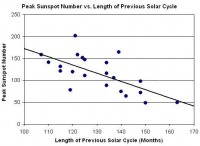
Only two solar cycles since 1750 have lasted as long as or longer than the most recent cycle, and both were followed by the weakest solar maximums of the past 250 years, a period during the early 1800s known as the Dalton Minimum. Given the length of the previous cycle, the upcoming solar cycle could be among the weakest on record since 1750 if the relationship holds. Additionally, of the last five solar cycles that persisted twelve or more months longer than average, four were followed by another cycle lasting longer than average. In every instance, however, the next solar cycle was somewhat shorter in length than the previous cycle.
Since net solar radiation is slightly higher during periods of heightened sunspot activity (and lower during periods of little sunspot activity), the combination of long solar cycles and low sunspot numbers results in cumulatively more months on a decadal time scale with below average net solar radiation. The result is that weak and long solar cycles lead to cooling on a global basis while short and intense solar cycles tend to result in warming on a global basis.
The following plot illustrates the relationship between the length of a given solar cycle and the average temperatures during the following solar cycle. Average global temperatures were calculated for each solar cycle (measured trough to trough) based on the GHCN-ERSST dataset (though the results are similar for the Hadley Center global temperature dataset) and compared to the length of the previous solar cycle. As can be seen, there is a solid relationship between solar cycle length and average global temperatures during the following solar cycle. This in turn leads to the possibility of using the solar cycle length as a means to at least partially predict temperature trends during the upcoming decade (enlarged here).
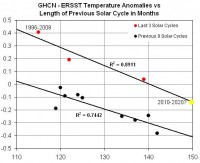
Besides the notable trend of cooler global temperatures following longer solar cycles and warmer global temperatures following shorter solar cycles, the other notable feature of the data is the distinctly higher temperature anomalies observed during the most recent three solar cycles. A trend line fitted through the most recent three solar cycles is nearly parallel to a trend line through the previous nine solar cycles, but is displaced 0.3-0.4°C higher. If the difference was purely the result of CO2 increases, a steadily increasing departure from the previous trend would be expected, and not a distinct jump and then a continuation of the old trend at a warmer temperature level. The timing of the data jump happens to be the mid-to-late 1970s, at a time of a noted global climate shift. The Pacific Decadal Oscillation changed from a negative to a positive phase at that time, and could explain part of the discrepancy. Improved ocean temperature estimates began during that time period as a result of satellite measurements, while at the same time a reduction in the number of land-based observation stations has occurred. Both of those factors, along with issues such as urban heat island growth could also play a role in the observed differences. There is also some chance that the apparent shift is simply an artifact of the limited number of data points. Finally, note that the warm 1996-2008 period followed the shortest solar cycle during the last 150 years. With the most recent solar cycle being the longest cycle of the past 200 or so years, the potential exists for significant global cooling during the upcoming decade. Even if the warmer trends of the past 30 years are utilized, below average global temperatures would still be possible during the next decade if the past trends hold.
While not quite as distinct as on a global scale, temperature trends for North America also have closely followed trends in solar cycle length as the plot below demonstrates. While temperature anomalies will likely not decline as much as might be suggested by the solar cycle length curve, the long solar cycle could at least help to drive North America temperature anomalies back down towards the long-term average (enlarged here).
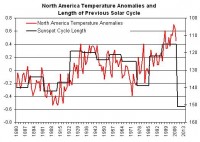
In conclusion, the upcoming decade will provide key data for research into both solar impacts on global climate and human-induced global warming. Since CO2 levels have been rising during a time of increasing solar activity, untangling the impacts of each on the global climate system is difficult. But, with rising CO2 levels and decreasing solar activity during the upcoming decade, the impacts of both should become more evident. See PDF here.
Data Sources:
Global and North America Temperature Anomaly Data.
Monthly Sunspot Number data.
|












